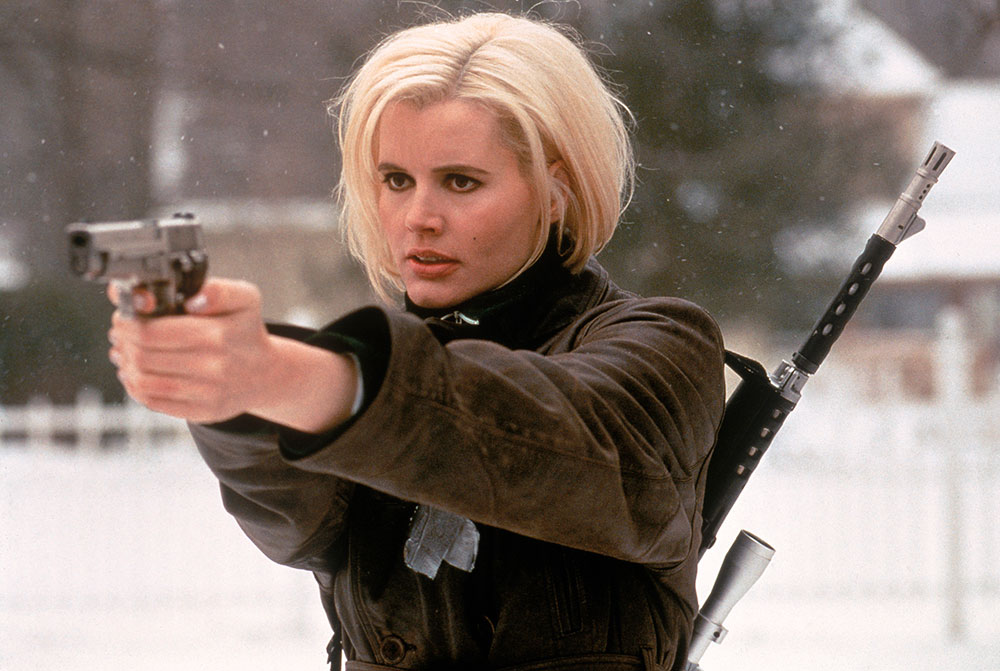The mnemonic is dramatized as the source of terror, humor, and action in Renny Harlin’s The Long Kiss Goodnight (1996). We first encounter Geena Davis’s CIA assassin Charly Baltimore under the alias of Samantha Caine, a stay-at-home mom with a live-in boyfriend and an eight-year-old daughter. Samantha likes to bake, is frail, and wails a lot. She arrived at her suburban haven with some lore—having washed up onshore, pregnant and with amnesia. Samantha is a living Jane Doe, a disappeared woman that functions as a walking myth to her community knowing that to somebody, somewhere, her disappearance is treated as an unsolemnized death, not true or real as it lacks a body. This all comes undone after she experiences a near-fatal car accident and remnants of her past life come back to take their revenge, figuratively and literally.
Charly repeatedly “hacks” into Samantha to perform expert hand-to-hand combat and gun knowledge that scandalize her daughter, boyfriend, and private investigator buddy Milton—a career-best performance by Samuel L. Jackson that is also a personal favorite of the actor’s. Samantha frequently believes that she was a chef in her past life due to her impressive, if deadly, use of knives, leaving her both amused and horrified at the potential bloodlust lurking within. Thanks to the film’s excellent comedic timing, this bit pays off in a sequence where upon killing an assassin with a glass pan of freshly baked lemon meringue pie, Charly/Samantha licks her bloodied fingers and whispers “chefs do that” to her shell-shocked boyfriend. Although it predates The Matrix (1999), the sudden access to hidden, embodied knowledge evokes Keanu Reeves’s iconic “Yeah, I know Kung-Fu” after he has a martial arts pack uploaded to his brain.
We can view The Long Kiss Goodnight as a cinematic representation of the philosopher David Humme’s bundle theory of the self, which posits that at any given moment we are always an accumulation of our past selves fighting for presentness. The truth, as the film laments, is that we are not always successful in burying our past. The real horror in The Long Kiss Goodnight is the realization that we may not actually like the version of ourselves that we’ve become, or that there is another version of us lying in wait to implode our lives and everything we thought we wanted and loved. And that happens despite our desire to keep the peace. There is always a fear that one day we will awake and not love the person next to us, or the hobbies, family, and friends that we spent so long clamoring for, as Charly does with Samantha’s boyfriend, daughter, and community.
The Long Kiss Goodnight quite literally reveals that our past will eventually catch up with us. It also unsentimentally examines the pain and mess of the afterbirth that accompanies becoming a new person. Though the film performed modestly well with critics and at the box office upon release, The Long Kiss Goodnight has largely fallen off the radar culturally. The film’s screenwriter, Shane Black, theorized that it being a woman-led action-amnesia film had much to do with it. It is a theory that has some weight, as only six years later The Bourne Identity (2002), a male-led amnesia-spy-action film, experienced global commercial and critical success (that spawned an unnecessary franchise). And while the audience’s mileage might vary with how well The Long Kiss Goodnight balances its tonal mood swings of humor, action, and mystery over the serious, self-aggrandizing aesthetics of most contemporary male-led thrillers, it has sex appeal and snappy dialogue. Not even the hardest of cinephile hearts can deny the dynamism of Charly—suspended from Christmas lights in a chic platinum bob and a smokey eye—yelling to the film’s villain, “Die screaming, motherfucker!”
The Long Kiss Goodnight screens this afternoon, October 13, at the Museum of Modern Art on 35mm as part of “Samuel L. Jackson: A Tribute.”



